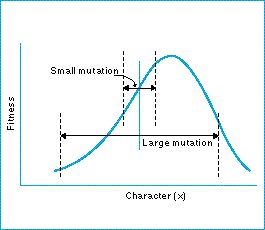Adaptive evolution model

The adaptive evolution model was devised by Fisher and is of general importance to population genetics. For almost any character there is likely to be a relation between the form of the character and its fitness, similar to that shown in the figure.
A mutation is equally likely to be in any direction from where the species is; one is equally likely to be 'up' hill as 'down' hill. The important relation is between the size of a mutation and the chance that it is an improvement:
• A large mutation If it is directed downhill, it will make its bearer worse adapted. If it is in the uphill direction, it might overshoot the peak and make the organism worse adapted by taking it further down the hill on the other side. This is the standard theoretical argument, showing that adaptations will not usually evolve by macromutations.
• A small mutation If it is downhill it will again make its bearer worse adapted; but if it is uphill it will probably be an improvement. The probability depends on how near the peak the species already is. If it is far off, quite a large mutation uphill can be favored; but if it is close to the peak the mutation will have to be very small.
The figure opposite shows a general model of evolution. For some trait (x), the fitness of an individual has an optimum at a certain value of x, and declines away from that point. There is then a "hill" of fitness values. A mutation which changes the value of x also changes its bearer's fitness.
| Next |



